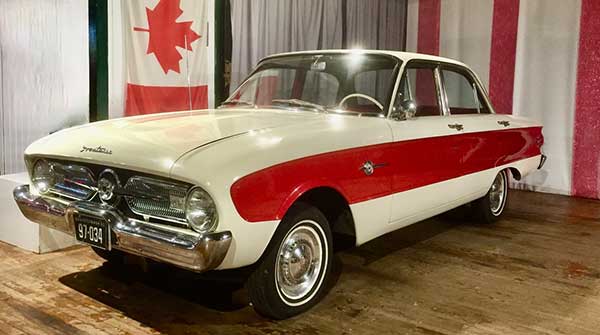Take a journey through Canada’s automotive history at the Canadian Automotive Museum
 The Canadian Automotive Museum in Oshawa, Ontario, is celebrating 60 years of sharing stories about Canadian cars.
The Canadian Automotive Museum in Oshawa, Ontario, is celebrating 60 years of sharing stories about Canadian cars.
The museum officially opened on September 23, 1963, after some Oshawa business people wanted to highlight the primary industry in their community, home of General Motors of Canada. However, the museum soon changed its focus to be more national in scope.
“It’s the world’s most significant collection of Canadian automobiles. Our mission is to preserve and share Canada’s automotive experience,” explains executive director and curator Alexander Gates.
The setting for the museum is ideal; it’s a former Chevrolet-Oakland dealership that opened in 1921.
 There are about 90 cars on display at the museum. |
 There are several McLaughlin-Buicks, including this 1908 Model F, one of 154 Model Fs made in Oshawa in 1908. |
 The Bricklin was engineered and designed in the U.S., and assembled in New Brunswick. |
 The Frontenac, a thinly-disguised Ford Falcon, was sold only for one year – 1960 – and only at Mercury dealers only in Canada. |
| Related Stories |
| Classic car contest raises money for cancer support
|
| From Regina to Moose Jaw: A Mazda CX-90 PHEV road trip
|
| Project Arrow is advancing the future of automobiles
|
Whether the cars were created in Canada, assembled in Canada, or just sold in Canada, their stories are told at the museum.
The most recent addition to the museum’s collection is a replica of what is believed to be the first successful gasoline-powered car in Canada, the Fossmobile. George Foss of Sherbrooke, Quebec, a machinist and bicycle mechanic, was 21 years old when he built his single-cylinder, high-wheeler. He sold it for $75 in 1902, but it’s not known what became of it. His grandson, Ron Foss, built a replica based on original photos and donated it to the Museum in December 2022.
Also from the very early days of the industry is the only surviving Redpath, a single-cylinder runabout produced in Kitchener, Ontario, in 1903.
Many early Canadian cars were joint ventures, as some Canadian carriage makers linked up with U.S. automakers that supplied engines, including the Gray-Dort and Tudhope-McIntyre.
The best-known example of this approach was McLaughlin-Buick. The McLaughlin Carriage Company, started in 1869, had become the largest carriage maker in the British Empire. With the coming of the automobile, a deal was reached with Billy Durant of Buick to provide engines and transmissions, which led to the launch of the McLaughlin Motor Car Company in 1907.
The new company later served as the foundation for General Motors of Canada, which was created in 1918. Sam McLaughlin became President of G.M. of Canada, with headquarters in Oshawa. The McLaughlin-Buick name was used in Canada until the Second World War. There are several McLaughlin-Buicks at the museum.
Some U.S. automakers set up assembly plants in Canada because Canadian-made cars could be shipped duty-free to other countries in the British Commonwealth, making them less expensive than U.S.-built cars. Ford was the first to use this approach in 1904, and among the cars on display is a 1909 Ford Model T, believed to be the earliest surviving Canadian-built Model T.
Other Toronto-made cars at the museum include a 1927 Dodge, a 1928 Durant and a 1937 Reo truck.
After the Second World War, Canadian branch plants of the Big Three assembled vehicles that were usually the same as U.S. models.
However, there were several Canadian-only models, such as the Meteor, sold at Mercury dealers.
Car buyers in Canada tended to prefer smaller and more economical cars than their American cousins, and Canadian versions of Dodges and Pontiacs were smaller than their American namesakes.
Also at the Canadian Automotive Museum is a 1960 Frontenac, which looks like a Ford Falcon, but a closer examination reveals slight trim differences, including maple leaves for trim on the front grill, hubcaps and steering wheel. The Frontenac was sold at Mercury dealers only in Canada for just one year.
The Canadian Automotive Museum also has more recent unique Canadian cars, like the 1971 Manic GT, a small sportscar based on a Renault and made in Granby, Quebec. Only about 160 Manics were produced. There is also a red 1975 Bricklin SV-1, assembled in New Brunswick.
One of the newer acquisitions is a 1987 Magna-Vehma Torrero, a massive luxury SUV created as a demonstration vehicle by the auto parts firm Magna International of Aurora, Ontario.
During the Covid-19 shutdown, extensive renovations were made to the museum, and a Zoom lecture series was started. These run on the third Thursday of each month and are available on YouTube.
Although there have been plenty of changes to the Canadian Automotive Museum during the past 60 years, what hasn’t changed is telling stories about unique and interesting Canadian cars.
Dale Johnson is an award-winning author, broadcaster and journalist who has worked in TV, radio, print and online.
For interview requests, click here.
The opinions expressed by our columnists and contributors are theirs alone and do not inherently or expressly reflect the views of our publication.
© Troy Media
Troy Media is an editorial content provider to media outlets and its own hosted community news outlets across Canada.

